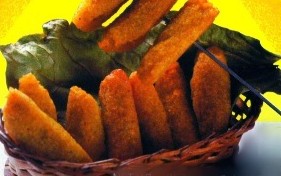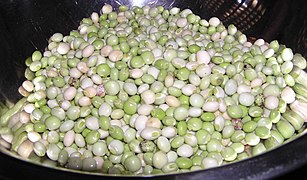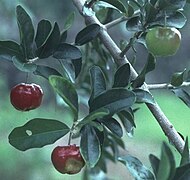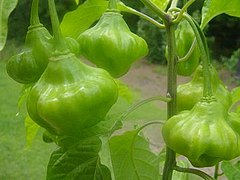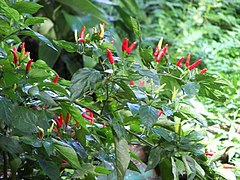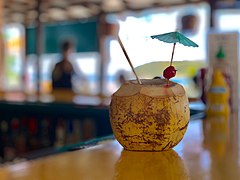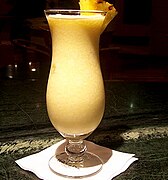Puerto Rican cuisine
| Part of a series on the |
| Culture of Puerto Rico |
|---|
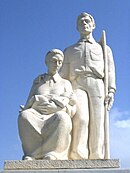 |
| Society |
| Topics |
| Symbols |
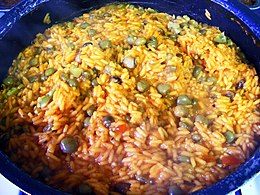
Puerto Rican cuisine has its roots in the cooking traditions and practices of native Taínos, colonial Spanish, and enslaved Africans.[4]
History

Puerto Rican cuisine is a product of diverse cultural influences, including Taíno Arawak, colonial Spanish, and enslaved Africans.[5] It is characterized by a unique blend of indigenous seasonings and ingredients, which sets it apart from both Spanish and other Latin American cuisines.[6][7] Locally, it is known as cocina criolla.[8][9]
The roots of traditional Puerto Rican cuisine can be traced back to the 19th century, when it became firmly established. In 1848, the first restaurant, La Mallorquina, was opened in Old San Juan.[10] The island's first cookbook, El Cocinero Puerto-Riqueño o Formulario, was published in 1849.[11]
Taíno influence
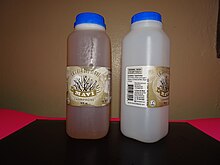
Many of the starchy root vegetables used in Puerto Rican cuisine, collectively known as viandas, have their roots in the diets of the indigenous Taíno people.[12][13] These include cassava (Spanish: yuca) and Tanier (Spanish: yautía)[14] which are staples in traditional Puerto Rican dishes.[15] Other popular root vegetables include Yam (Spanish: ñame), sweet potato (Spanish: batata), and taro (Spanish: malanga), all of which are cultivated in the mountain regions of the island.[16]
It is hypothesized that Taínos used cooking methods that resemble what is called barbecue today. By some counts, the earliest recorded use of the term barbecue can be traced back to a journal entry made by a Spanish colonizer upon landing in the Caribbean.[17] The term was used by the indigenous Taino people, who referred to the practice of slow-cooking food over a raised wooden platform as barabicu, which means "sacred pit" in their language.[18] While the Tainos likely slow-roasted fish due to the region and their diet at the time, this cooking method may have given rise to what we know today as barbecue.[17]
Spanish/European influence

See: Spanish cuisine
- Arroz con dulce – In Puerto Rico rice pudding is made with rice, sugar, coconut milk, milk, clove, cinnamon, ginger, star anise, rum, and raisins. There are other variations that include purees added such as squash, sweet plantains, batata, yuca, and ripe breadfruit. Cream cheese and pistachios are popular and a rice pudding made with additional egg, lemon peel, and cream cooked just like crème brûlée. The first written record known to exist about this dish dates 1859 but historians can trace it as far back as the 16th century.[19]
- Flan – A milk and caramel custard very popular throughout Puerto Rico. There are several ways to make this dish. Some are unique to Puerto Rico, such as breadfruit and sesame seeds. Coconut[20] and pumpkin[21] are two popular varieties.
African influence
See: African cuisine
Coconuts, coffee (brought by the Arabs and Corsos to Yauco from Kafa, Ethiopia), okra, taro (malanga), tamarind, yams (ñame), sesame seeds, gandules (pigeon peas), plantains, many varieties of bananas, other root vegetables and Guinea hen, all came to Puerto Rico from, or at least through, Africa. African slaves also introduced the deep-frying of food, such as cuchifritos.[22]
Regional
Arecibo
Arecibo is the biggest municipality in Puerto Rico by area and is located on the northern coast. In the Río Grande de Arecibo, whitebait called cetí is caught.[23]
Basic ingredients
Seafood and shellfish

On some coastal towns of the island, such as Luquillo, Fajardo, and Cabo Rojo, seafood is quite popular.
- Cetí – A type of whitebait found in Arecibo.[24]
- Chillo – Red snapper is a favorite among the locals.[25]
Seasoning
Traditional cooking on the island uses more fresh and local ingredients such as citrus to make mojo and mojito isleño and especially fresh herbs, vegetables and peppers to make recaíto and sofrito.[26]
The base of many Puerto Rican main dishes involves sofrito, similar to the mirepoix of French cooking, or the "trinity" of Creole cooking. A proper sofrito is a sauté of freshly ground garlic, tomatoe sauce, yellow onions, recao/culantro, cilantro, red peppers, cachucha and cubanelle peppers. Sofrito is traditionally cooked with olive oil or annatto oil, tocino (bacon), salted pork and cured ham. A mix of stuffed olives and capers called alcaparrado are usually added with spices such as bay leaf, sazón and adobo.[27]
Puerto Rican dishes

Although Puerto Rican diets can vary greatly from day to day, there are some markedly similar patterns to daily meals. Dinners almost invariably include a meat, and rice and beans.[5]

Codfish and taro is also a popular dish.
Thanksgiving dishes
Thanksgiving is relatively new in Puerto Rico—the islanders adopted it when they became a U.S. Territory in the late 1800s. Locals really embrace it, however. Just like on the U.S. mainland, shops close, families come together, ridiculous amounts of food get prepared and eaten and families and friends. Thanksgiving kicks off the holidays in which to come Christmas, New years and 3 kings day. Many Christmas dish like arroz con gandules, roasted pork, and pastlese are a part of the gathering but are frequently changing as time passes and adopting new recipes and traditions. For example the classic coquito drink can be made with added pumpkin and additional spices. Arroz con gandules can be replaced with arroz con maiz and salchichas prepared almost the same but with wine added. Roasted pork can be replaced with roasted turkey stuffed with mofongo. And of course sweets are always a part of ending meal with flan made with sweet potato or pumpkin, Cazuela (a pie made with pumpkin, sweet potato, coconut, and spices), bread pudding cooked in the same style as crème caramel with sweet plantains and raisins, cheese cake with guava and pineapple.[28]
Christmas dishes
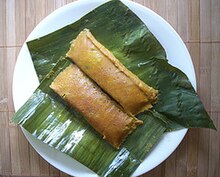
Puerto Rican culture can be seen and felt all year-round, but it is on its greatest display during Christmas when people celebrate the traditional aguinaldo and parrandas – Puerto Rico's version of carol singing. Puerto Rican food is a main part of this celebration. The main dishes are arroz con gandules, roasted pork (lechón), pasteles, coquito (coconut and rum eggnog), tembleque (coconut pudding), and other dishes, desserts, and drinks to complement the meal.
Beverages

Birthplace of the iconic piña colada and rum capital of the world, Puerto Rico's has an impressive thriving cocktail scene with some of the best bars in the world. Named Bartender of the Year in 2017 by the International Rum Conference (IRC), Berdecia’s first enterprise, La Factoría, remains the only bar in Puerto Rico and the second in Latin America to be listed among the World’s 50 Best Bars. With other bars and restaurants threw out the island following there footsteps. Puerto Rico might be known for its Piña colada and famous holiday drink made with coconut milk, cream, spices, eggs, and rum known as coquito, the island holds strong on other traditional drinks.
Bilí is a fermented made with Spanish lime (quenepas) or cherries, spices, rum, and ginger.
Chichaíto is normally served in a shot glass, it’s said to have originated during the 1930s in Puerto Rico. This Cocktail can be very easy to make, the simple way is to pour one part Anisette and one part White Rum into a shot glass. You can also customise the Cocktail, by adding some lemon juice, changing the measurements, adding sweet spices, a coffee grain, coconut milk or cream or even adding in some fruit juices. It’s also recommended to shake the ingredients with some ice in a Cocktail shaker to get a chilled experience.
Not all drinks are alcohol base as the island enjoys fresh fruit juice made from pineapples, mangos, guava and other fruits. Coconut water is popular, cheap and most places even free as coconuts are abundant threw out the island. Horchata made with toasted sesame seeds, coconut milk, cinnamon, sugar and vanilla. Piragua vendors are a local favorite usually sold buy one person owning cart selling shaved ice similar to a snow cone with multiple flavors. Maví a fermented drink made from tree bark is Taíno and Arawak tradition that's still strong threw out the Caribbean. Malt drink and soda are equally available and consumed. Malt can be drank alone of in a shake with raw eggs and condensed milk. Malt is also used for a ice cream float. The coconut soda and champagne soda both originated in Puerto Rico.
Coffee and hot chocolate are usually made in the morning simply with milk or adding spices or a small amount of edam cheese[29]. Puerto Rico is world renound for it famous coffee said to be some of the best in the world and the best in the Caribbean. Puerto Rico was often called the island of coffee and its coffee was preserved for kings, queens and popes.
Kiosks
List of cuchifrito and kiosks food
Rustic stalls displaying many kinds fritters under heat lamps or behind a glass pane can be spotted in many places throughout Puerto Rico. Collectively known as frituras, these snacks are called cuchifritos in New York City, but to be strictly correct, cuchifritos are the mom-and-pop stores where frituras are sold. In Puerto Rico, the name quiscos (kiosk) is used to refer to the cuchifrito.[30][31] Quioscos are a much-frequented, time-honored, and integral part to a day at the beach and the culinary culture of the island. Fresh octopus and conch salad are frequently seen. Much larger kiosks serve hamburgers, local/Caribbean fusion, Thai, Italian, Mexican and even Peruvian food. This mixing of the new cuisine and the classic Puerto Rican food. Alcoholic beverage are a big part of kiosks with most kiosks having a signature drink.
Puerto Rican food outside Puerto Rico
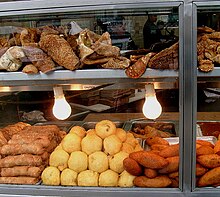

- Cuchifritos – In New York, cuchifritos are quite popular. Cuchifritos, often known as "Puerto Rican soul food"[by whom?] includes a variety of dishes, including, but not limited to: morcilla (blood sausage), chicharron (fried pork skin), patitas (pork feet), masitas (fried porkmeat), and various other parts of the pig prepared in different ways.
- Jibarito (plaintain sandwich) – In Chicago, el jibarito is a popular dish.[32] The word jíbaro in Puerto Rico means a man from the countryside, especially a small landowner or humble farmer from far up in the mountains. Typically served with Puerto Rican yellow rice, Jibaritos consist of a meat along with mayonnaise, cheese, lettuce, tomatoes and onions, all sandwiched between a fried plantain, known as a canoa (canoe). In the early 20th century, bread made from wheat (which would have to be imported) was expensive out in the mountain towns of the Cordillera Central, and jíbaros were made from plantains which are still grown there on the steep hillsides. The version introduced to Chicago was originally made with skirt steak, but today it can be found in versions made with chicken, roast pork, ham, shrimp and even the vegetarian option tofu is available.[33]
Chefs
- Alfredo Ayala - was recognized as the father of Puerto Rican modern cuisine[34]
- Doreen Colondres - chef, television presenter, food writer and sommelier
- Luis Antonio Cosme – Puerto Rican actor and television chef
- Giovanna Huyke – television chef
- Dora Romano – author of Cocine Conmigo[35] written in 1972
- Daisy Martinez – author of Daisy Cooks: Latin Flavors That Will Rock Your World written in 2005 and Daisy: Morning, Noon and Night written in * of Daisy Cooks! on PBS and ¡Viva Daisy! on the food network
- Maria Perez – author of Tropical Cooking Made Easy [36] written in 2007
Gallery
-
Table with typical sweets in Húcares, Naguabo
-
Rotisserie chicken, twice-fried plantain in Ciales, Puerto Rico
-
Alcapurrias
-
Papa rellena de Puerto Rico
-
Mofongo, prepared in New York
-
pigeon peas (gandules)
-
Yuca, Puerto Rican name for cassava
-
Acerola cherry
-
Green and red cubanelle peppers are used to make sofríto
-
Plantain "arañitas" and "tostones rellenos"
-
Ajicitos / Cachucha, a.k.a., Ají Dulce, the Habanero chili pepper's mild cousin
-
Ajíes caballero (aka, Puerto Rican Jelly Bean Hot Chili Pepper) is a very hot local pepper
-
Marinated cassava (Spanish: Yuca en escabeche)
-
Parcha, passion fruit, is often made into passion fruit juice
-
Coconut with straw at restaurant in Esperanza, Vieques
-
Pique (Puerto Rican Hot Sauce)
-
Piña Colada
-
Puerto Rican cooking has a unique blend of influences.
-
Grilled yellow snapper with green papaya salad and tostones
See also
References
- ^ Reporter's Notebook. York Daily Record (York, Pennsylvania). 15 December 2003. Page 35. Accessed 24 January 2021.
- ^ El Gusto Boricua en el Sur de la Florida. Yined Ramírez-Hendrix. El Nuevo Herald (Miami, Florida). 27 July 2011. Page D12. Accessed 24 January 2021.
- ^ Sofrito, imprescindible para latinos. Viviana Caraballo. El Nuevo Herald (Miami, Florida). 6 January 1999. p. 19. Accessed 24 January 2021.
- ^ Proctor, Tammy (November 28, 2022). "Eating the Past: The rich history of Puerto Rican food". UPR. Archived from the original on January 28, 2023. Retrieved April 27, 2023.
- ^ a b Albala, Ken (2011). Food Cultures of the World Encyclopedia. Greenwood. p. 656 – via Temple University.
- ^ "Herencia de los taínos". EnciclopediaPR. Retrieved April 27, 2023.
- ^ Diaz, Von (March 22, 2021). "Von Diaz's Essential Puerto Rican Recipes". The New York Times. ISSN 0362-4331. Retrieved April 27, 2023.
- ^ "What Are Puerto Rican Food Staples?". The Spruce Eats. Retrieved April 27, 2023.
- ^ Torres-González, Joseph A. (2021). "Review of De los plátanos de Oller a los Food Trucks: Comida, alimentación y cocina puertorriqueña en ensayos y recetas". Caribbean Studies. 49 (2): 184–186. ISSN 0008-6533.
- ^ Porter, Darwin; Prince, Danforth (June 25, 2007). Frommer's Portable Puerto Rico. Wiley. ISBN 9780470100523.
- ^ Ortiz, Yvonne. A Taste of Puerto Rico: Traditional and New Dishes from the Puerto Rican Community. Penguin group, 1997. P. 3
- ^ "Taino | History & Culture | Britannica". www.britannica.com. Retrieved April 28, 2023.
- ^ Ortiz Cuadra, Cruz (September 16, 2011). "Las viandas: esa entrañable relación con la comida de las madres". 80 grados. Retrieved April 27, 2023.
{{cite web}}: CS1 maint: url-status (link) - ^ Barrett, Otis Warren (1905). The Yautias, Or Taniers, of Porto Rico. Porto Rico Agricultural Experiment Station.
- ^ Magazine, Smithsonian. "What Became of the Taíno?". Smithsonian Magazine. Retrieved April 28, 2023.
- ^ Raíces y Tubérculos. Centro de Recursos Informativos Digitales Agrícolas de Puerto Rico (CRIDAg). University de Puerto Rico en Mayaguez. 2018. Accessed 8 December 2018.
- ^ a b M, K. "The History of Barbecuing". The Food Network. Retrieved April 27, 2023.
{{cite web}}: CS1 maint: url-status (link) - ^ "Tienen historia: ¿BBQ o barbacoa?". Primera Hora (in Spanish). October 24, 2016. Retrieved April 28, 2023.
- ^ Arroz con dulce: ese histórico obsequio de Reyes. Cruz Miguel Ortiz Cuadra, PhD. 80 Grados: Prensa sin Prisa. 3 January 2012. Accessed 15 January 2022. Archived.
- ^ Flan de coco. Zulma Santiago. Welcome to Puerto Rico. Accessed 25 July 2022. Archived.
- ^ Flan de Calabaza. Cielito Rosado. Bordens de Puerto Rico. undated. Accessed 25 January 2022. Archived.
- ^ "A slice of Puerto Rican history". The Salt Lake Tribune.
- ^ "Historia del Cetí en Puerto Rico y el Caribe". foodiespr.com (in Spanish). February 3, 2015. Retrieved August 25, 2019.
- ^ Historia del Cetí en Puerto Rico y el Caribe. Ferdinand Quiñones. FoodiesPR.com February 2015. Accessed 25 January 2022. Archived.
- ^ Nos gusta el bacalao, pero el chillo es el rey de la mesa puertorriqueña Según varios expertos, el chillo es el pescado favorito de los consumidores del país. Agustín Criollo Oquero. Primera Hora. 12 August 2014. Accessed 25 January 2022. Archive.
- ^ "The ultimate Puerto Rican food guide". Explore Parts Unknown. October 1, 2017. Retrieved August 25, 2019.
- ^ Taylor, David (June 5, 2020). "Legendary Puerto Rican Cookbook Cocina Criolla begins with many details & Sofrito!". Hispanic Food Network. Retrieved June 22, 2020.
- ^ Ortiz Cuadra, Cruz Miguel (2013). Eating Puerto Rico: A History of Food, Culture, and Identity. Latin America in Translation/en Traducción/em Tradução. University of North Carolina Press. p. 82. ISBN 978-1-4696-0882-2. Retrieved October 12, 2019.
- ^ Halpern, Ashlea (April 30, 2014). "18 Things to Eat, Buy and Do in Puerto Rico - Casa Cortés ChocoBar". Bon Appetit. Condé Nast.
- ^ Frituras. Recetas Boricuas. Accessed 25 January 2022. Archived.
- ^ Las frituras son nuestro manjar-VÍDEO: Un sondeo informal por el área de Piñones demostró que la alcapurria es la gran favorita. Istra Pacheco. Primera Hora. 26 July 2013. Accessed 25 January 2022. Archived.
- ^ "Jibarito Sandwich: What You Need To Know". Retrieved April 28, 2016.
- ^ Bizzari, Amy (2016). Iconic Chicago Dishes, Drinks and Desserts. Arcadia. pp. 46–53. ISBN 9781467135511.
- ^ Solí, Por Yaira; Escudero, s; Vocero, El (November 14, 2016). "Fallece un 'boomer' ilustre: chef Alfredo Ayala". El Vocero de Puerto Rico (in Spanish). Retrieved November 18, 2020.
- ^ Romano, Dora R. de (1972). Cocine conmigo (in Spanish). ISBN 9788439910138.
- ^ Perez, Maria (2007). Tropical Cooking Made Easy. Hillcrest Publishing Group. ISBN 9781934248607.
External links
- El Boricua - Puerto Rican traditional recipes
- Carmen Santiago, Puerto Rican chef Archived November 11, 2019, at the Wayback Machine



